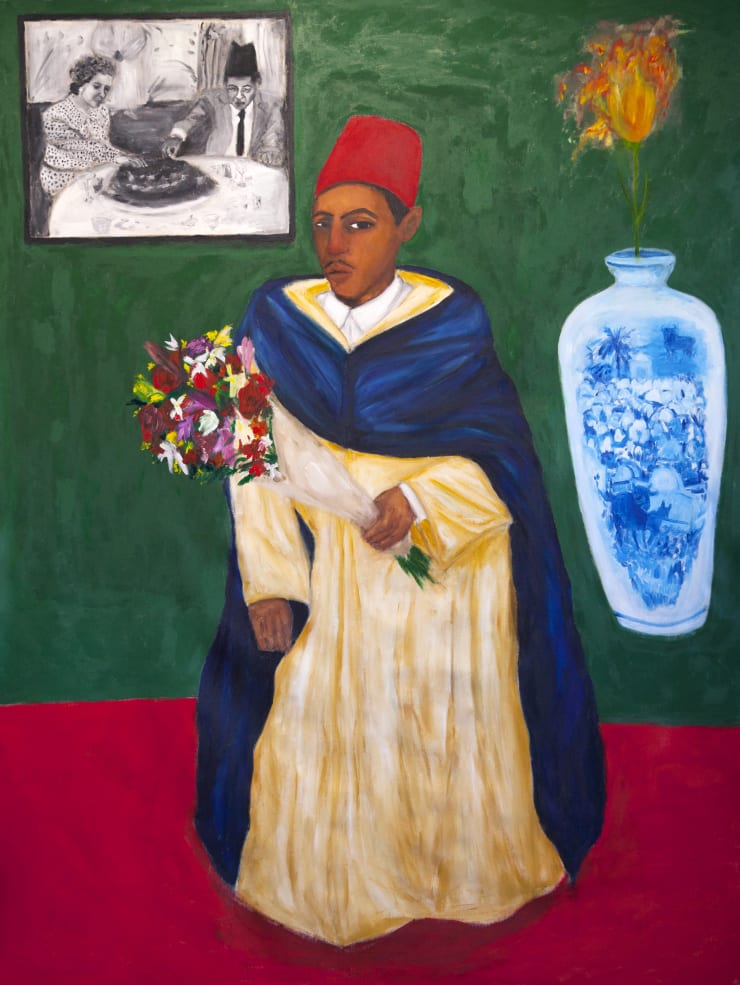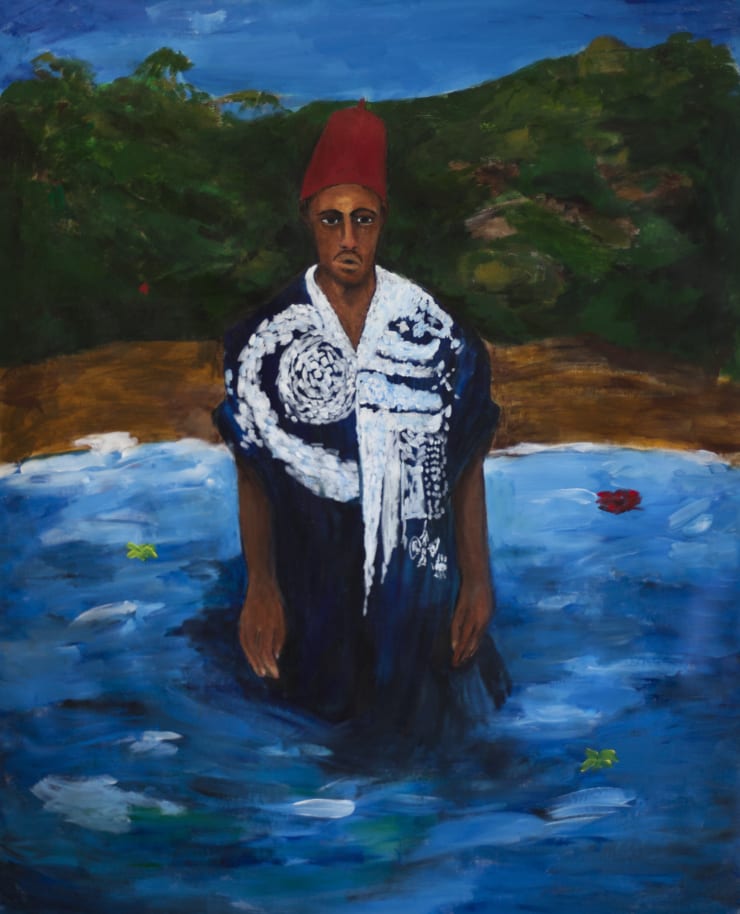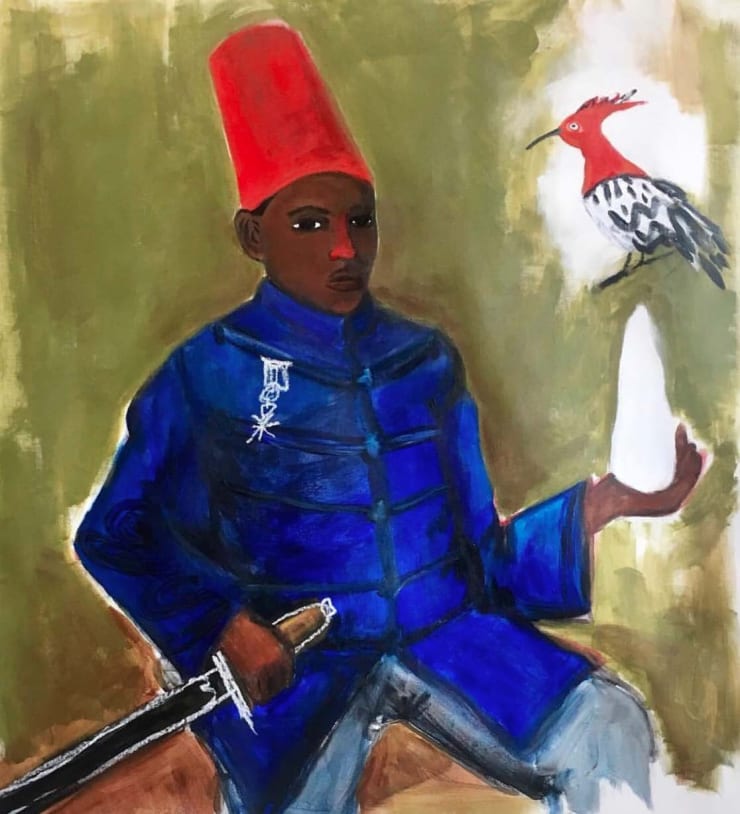-
Anuar Khalifi
Palimpsests1 July – 30 July 2021
-
The Third Line is pleased to present a selection of recent works by Anuar Khalifi.
-

-
-
The theme of palimpsests is explored further in the works made in the past year which centre around a single figure, highlighting an isolated existence, as felt by the artist himself no doubt. Inspired chiefly by current events, the artist depicts recognisable moments in present and past collective memory and superimposes his feelings and reactions about it. Physically and metaphorically inserting himself in the picture, and by extension, challenging representation as well as social and political responses to these events. Asking the ever pressing question: who (re)writes history?
Anuar’s clever manipulation of modernist painting techniques and the genre of portraiture, as well as his choice of subject matter (down to their outfits and skin colour) all play a critical role in challenging representation in art and asserting presence in cultural institutions; re-writing art history.
Delving deeper into the artist’s process, I was pleased to have a conversation with him... -
On Process...
For me, the process of painting in this craft is the most important thing. I get my inspiration from what I read and what I see; the world informs me. While I am self-taught, as an artist you have eyes, and you’re always being influenced. I read a lot about Sufism and tradition, and this informs my work. Then, when I get that certain sense of urgency, it means it’s time to start something. I don’t do sketches anymore, because it reveals the form, I like to discover things while I’m painting. The painting is a mystical being but painting is really hard. I never have absolute control over the painting, and that’s visible in my work. I know what I’m doing, only when I’m doing it. It’s kind of magic.
-
The painting is a mystical being but painting is really hard. I never have absolute control over the painting, and that’s visible in my work. I know what I’m doing, only when I’m doing it. It’s kind of magic.
-
On the characters...
In recent works shown here, my characters look more calm and the paintings are less chaotic. In older works, I was living in Morocco and everything around me was more chaotic which translated into the paintings. But since I’ve come back to Spain, myself and the paintings have shifted to a calmer, more focused solitude in the studio. I am tackling bigger questions, but I am thinking of simpler answers. Perhaps it’s my age or the point I am in my personal painting journey.
The characters you see are from my imagination. Often I reference a real event or image within the painting, and offer my own commentary through the paintings’ main protagonists. When I do, the real image is painted in a different surface or a different medium. In a new painting (title TBC) I even recreated an image in a jar from a picture I took of a graveyard in Tangier, almost like putting it in a time capsule. You can also see this in ‘Safi Safari’. For me, it makes no sense to me to paint a photo exactly the way it is, I like to add my own spin. In a way, I use these tools to create a mixed media of what’s real and what’s imaginary. Actually, I can paint quite realistically, but it’s not what I love. I like to paint more childishly so I can connect with that part of me. I like to paint without shadow because I’m more interested in the surface of the painting. For me the painting is not the characters, but rather laying down a feeling or a thought onto the painting surface.
-
I am tackling bigger questions, but I am thinking of simpler answers.
-
On representation...
My characters, who they are, they are me in some ways, but more enigmatic. In the recent works, they feature more predominantly, like heroes. It may seem strange to call them autobiographical, but everything you do as an artist is autobiographical. My paintings are a way to put “us” or people that represent me in museums. So many of them now look like classical portraits, referencing the likes of Velasquez or Goya. For example, I am drawn to paintings like Valesquez’s portrait of his assistant Juan de Pareja, who was himself a notable painter. Juan de Pareja was a Morisco (Spanish Muslim) born into slavery and later freed by Valesquez. Ironically, most of his paintings were Christian religious scenes. In those days, he was described as “of mixed race and strange colour“. I just see a guy who looks like me! He is probably the most familiar face I can find in a classic museum. Also, being born in Spain myself, the history of the Moriscos resonates with me and my search. That painting is a masterpiece but for obvious reasons I get mixed feelings since it is probably one of few depictions I can find of “muslims” - so I am trying to rectify that.
-
My paintings are a way to put “us” or people that represent me in museums.
-
On humour, space and time...
In recent works like ‘Safi Safari’ for example, it has a deeper spiritual meaning to it, but it also has lightness and a sense of humor. I like my paintings to operate between these two spaces, with sense of humour as a hook that draws you in. My paintings are conversations I have with myself without taking myself too seriously. The subject matter is sensitive but not that emotional. When I’m going through the process of connecting two worlds of different space and time, it’s magic. When people approach my work, I want them to feel it, but I don’t want to be too “in your face” with spirituality or deeper meaning.
-
My paintings are conversations I have with myself without taking myself too seriously.
-
On stereotypes and male identity…
Recently I got tired painting North African stereotypes, like characters with track suits, and I started painting them with traditional garments, which has taken me time to tackle without being orientalist. I’ve had my conflicts with orientalism, but I grew to appreciate it despite my feelings about it. I don’t always paint things I like or love, but rather I’m trying to have a conversation. I think my characters are now more adult, more mature. I try to avoid the clichés of looking like you’re from the Modern world. They resemble classic portraits more now. They are me, but not directly me. For example, the main subjects are all male since I work predominantly in identity, and it’s what I relate to. I am talking about my own experience. They are also growing up now, I think they’re going to have my age too.
-
On storytelling and meaning…
There is a strong element of storytelling in the works as well. Seeking meaning is at the forefront of the Muslim psyche, “meaning precedes form” (Al Ma’ani kabl al mabany) is an Arabic proverb, and to me, it is the significance of art and I wanted to explain that with my paintings. I tell the story, and it’s up to the viewer to superimpose the meaning as they see it.
For example, in a painting I am working on now, I included the image of a famous photograph of Queen Elizabeth and King Hassan II in Morocco eating a meal using their hands from 1980. I think it is a powerful image and has multiple interpretations in the context of a painting. I wanted to recreate the sensation/reaction to the photo now in my painting, and have my own say about it or express how I feel about it. The past is always super present in my paintings.
-
The past is always super present in my paintings.
-
On Music, Sufism and Negus…
Music has always been around me, and it is always referenced in my works. Many of the titles of my works are from songs or poetry. Most of the recent works come from Sufism. To me painting is akin to the Dervish way, much like Goya related his works to bullfighting traditions.
As a seeker of truth like a dervish using metaphors
I see every work a form of revealing veils
you can find truth in metaphors and beauty and justice in truth
More recently, my collaboration with yasiin bey was a manifestation of destiny! I included one of his albums in one of my paintings from 10 years ago before we met and worked on Negus. The first work I did for Negus was a cartography of my encounters with yasiin and my visual remix or interpretation of the album and a portrait of him. In the second piece I was trying to capture the same work and the album from a distance. yasiin and I became really close friends and collaborators. I guess that also shaped the way I did the second work more coded.
yasiin is also closely involved in a short movie documentary about my work directed by Jordi Esgleas Marroi. The initial idea was having me try to explain my work and subject matter but we thought since in my opinion one of the most eloquent and important living artists is my friend, we ask yasiin to collaborate and the end result is something like “Anuar Khalifi by yasiin bey'' and the result is overwhelming! Stay tuned for more details on screenings soon!
-
Most of the recent works come from Sufism. To me painting is akin to the Dervish way
-
-
About Anuar Khalifi
Self-taught artist Anuar Khalifi was born in 1977 in Lloret de Mar, Spain. Currently based between Barcelona and Tangier, Anuar creates richly detailed and vibrant paintings that reward the keen eye with their captivating layers of meaning. Within these layers, the artist explores a wide range of themes such as identity, duality, diaspora, orientalism, colonialism, extremism, and consumerist society.
Anuar has exhibited in a number of solo and group exhibitions in the Middle East, Europe and North Africa including but not limited to; Ce qui s’oublie et ce qui reste, Musée National de l’histoire de l’immigration, Paris (2021); Personal Mythologies, Galerie Julien Cadet, Paris (2020); and Forever Is A Current Event, The Third Line, Dubai (2019). Anuar's work has been acquired by MACAAL, Musée d'Art contemporain africain Al-Maaden, Marrakech, Morocco.
-
About Dina Ibrahim
Dina Ibrahim is a writer and curator based in London. She currently holds the position of Exhibitions Manager at the Victoria and Albert museum, London.
-
Works
-

Anuar Khalifi, Mawqif, 2020, Acrylic on canvas, 145 x 114cm
-

Anuar Khalifi, Safi Safari, 2021, Acrylic on canvas, 119.5 x 170cm
-

Anuar Khalifi, MOCKINGBIRD, 2018, Acrylic on canvas, 85 x 75cm
-

Anuar Khalifi, BABA THE BUTCHER AND GARDNER, 2019, Acrylic on canvas, 105 x 95cm
-

Anuar Khalifi, A MAN CHEST CAN ONLY HOLD ONE, 2020, Acrylic on canvas, 184 x 152cm
-

Anuar Khalifi, THE OPENING, 2020, Acrylic on canvas, 210 x 200cm
-

Anuar Khalifi, THE LIGHT BLOSSOM, 2020, Acrylic on canvas, 190 x 139cm
-

Anuar Khalifi, UNTITLED (SCOOTER), 2020, Acrylic on canvas, 98 x 77cm
-

Anuar Khalifi, Ghurba, 2020, Acrylic on canvas, 112 x 137cm
-

Anuar Khalifi, Na3na3, 2020, Acrylic on canvas, 193 x 158.5cm
-

Anuar Khalifi, Palimpsest, 2021, Acrylic on canvas, 246 x 192cm
-
-
Please click here for Anuar's CV.















